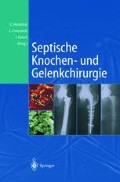Zusammenfassung
Staphylokokken gehören zu den häufigsten Infektionserregern bei septischen Gelenk- und Knocheninfektionen. Insgesamt hat sich in den letzten Dekaden diese Erregergruppe zu ausgesprochenen Problemkeimen insbesondere in Krankenhäusern entwickelt. Die Koagulase-positive Spezies Staphylococcus aureus hat dabei ein breites pathogenes Potential und löst sehr unterschiedliche Erkrankungen aus, deren Spektrum von oberflächlichen Haut- und Wundinfektionen bis hin zu lebensbedrohlichen systemischen Infektionen und chronischen Krankheitsbildern reichen kann. Die Ausprägung dieser Infektionen hängt dabei einerseits von der Ausstattung des jeweiligen Erregers mit entsprechenden Virulenzfaktoren wie beispielsweise Adhäsinen und Toxinen ab, andererseits wird sie aber auch wesentlich vom Immunstatus und der Grunderkrankung des Patienten mitbestimmt. Obwohl Koagulase-negative Staphylokokken wie Staphylococcus epidermidis in erster Linie ein Bestandteil der gesunden Hautflora des Menschen sind, bildet Staphylococcus epidermidis heute die häufigste Ursache von Infektionen in Verbindung mit medizinischen Implantaten und Fremdkörpern. Die Therapie von nosokomialen Staphylokokkeninfektionen wird durch die ausgeprägte Neigung zur Antibiotikaresistenz erschwert, und es ist bis heute wenig verstanden, wie und warum sich Staphylokokken so außerordentlich erfolgreich und dauerhaft als Erreger im Hospitalmilieu etablieren konnten. In den folgenden Abschnitten soll daher auf einige Aspekte der Biologie dieser Bakteriengruppe näher eingegangen werden.
Access this chapter
Tax calculation will be finalised at checkout
Purchases are for personal use only
Preview
Unable to display preview. Download preview PDF.
Literatur
Berger-Bächi B (1999) Genetic basis of methicillin resistance in Staphylococcus aureus. Cell Mol Life Sei 56: 764–770
Cho SH, Naber K, Hacker J, Ziebuhr W (2002) Detection of the icaADBC gene cluster and biofilm formation in Staphylococcus epidermidis isolates from catheter-related urinary tract infections. Int J Antimicrob Agents 19: 570–575
Foster TJ, Hook M (1998) Surface protein adhesins of Staphylococcus aureus. Trends Microbiol 6:484–488
Götz F (2002) Staphylococcus and biofilms. Mol Microbiol 43: 1367–1378
Heilmann C, Hussain M, Peters G, Götz F (1997) Evidence for autolysin-mediated primary attachment of Staphylococcus epidermidis to a polystyrene surface. Mol Microbiol 24: 1013–1024
Heilmann C, Thumm G, Chhatwal GS, Hartleib J, Uekotter A, Peters G (2003) Identification and characterization of a novel autolysin (Aae) with adhesive properties from Staphylococcus epidermidis. Microbiology 149: 2769–2778
Hell W, Meyer HG, Gatermann SG (1998) Cloning of aas, a gene encoding a Staphylococcus saprophyticus surface protein with adhesive and autolytic properties. Mol Microbiol 29: 871–881
Hiramatsu K, Okuma K, Ma XX, Yamamoto M, Hori S, Kapi M (2002) New trends in Staphylococcus aureus infections: glycopeptide resistance in hospital and methicillin resistance in the community. Curr Opin Infect Dis 15: 407–413
Kresken M, Hafner D, Schmitz F-J, Wichelhaus TA für die Studiengruppe (2003) Resistenzsituation bei klinisch wichtigen Infektionserregern gegenüber Antibiotika in Deutschland und im mitteleuropäischen Raum. Bericht über die Ergebnisse einer multizentrische Studie der Arbeitsgemeinschaft Empfindlichkeitsprüfung & Resistenz der Paul-Ehrlich-Gesell-schaft für Chemotherapie e. V. aus dem Jahre 2001. Antiinfective Intelligence, Bonn
Loessner I, Dietrich K, Dittrich D, Hacker J, Ziebuhr W (2002) Transposase-dependent formation of circular IS256 derivatives in Staphylococcus epidermidis and Staphylococcus aureus. J Bacteriol 184: 4709–4714
McNamara PJ, Proctor RA (2000) Staphylococcus aureus small colony variants, electron transport and persistent infections. Int J Antimicrob Agents 14: 117–122
Proctor RA, van Langevelde P, Kristjansson M, Maslow JN, Arbeit RD (1995) Persistent and relapsing infections associated with small-colony variants of Staphylococcus aureus. Clin Infect Dis 20: 95–102
Rachid S, Ohlsen K, Witte W, Hacker J, Ziebuhr W (2000) Effect of subinhibitory antibiotic concentrations on polysaccharide intercellular adhesin expression in biofilm-forming Staphylococcus epidermidis. Antimicrob Agents Chemother 44: 3357–3363
von Eiff C, Heilmann C, Proctor RA, Woltz C, Peters G, Götz F (1997) A site-directed Staphylococcus aureus hemB mutant is a small-colony variant which persists intracellularly. J Bacteriol 179: 4706–4712
Weigel LM, Clewell DB, Gill SR, Clark NC, McDougal LK, Flannagan SE, Kolonay JF, Shetty J, Killgore GE, Tenover FC (2003) Genetic analysis of a high-level vancomycin-resistant isolate of Staphylococcus aureus. Science 302: 1569–1571
Ziebuhr W, Dietrich K, Trautmann M, Wilhelm M (2000) Chromosomal rearrangements affecting biofilm production and antibiotic resistance in a Staphylococcus epidermidis strain causing shunt-associated ventriculitis. Int J Med Microbiol 290: 115–120
Ziebuhr W, Heilmann C, Götz F, Meyer P, Wilms K, Straube E, Hacker J (1997) Detection of the intercellular adhesion gene cluster (ica) and phase variation in Staphylococcus epidermidis blood culture strains and mucosal isolates. Infect Immun 65: 890–896
Ziebuhr W, Krimmer V, Rachid S, Loessner I, Götz F, Hacker J (1999) A novel mechanism of phase variation of virulence in Staphylococcus epidermidis: evidence for control of the polysaccharide intercellular adhesin synthesis by alternating insertion and excision of the insertion sequence element IS256. Mol Microbiol 32: 345–356
Ziebuhr W, Loessner I, Krimmer V, Hacker J (2001) Methods to detect and analyze phenoty-pic variation in biofilm-forming Staphylococci. Methods Enzymol 336: 195–205
Editor information
Editors and Affiliations
Rights and permissions
Copyright information
© 2004 Springer-Verlag Berlin Heidelberg
About this chapter
Cite this chapter
Ziebuhr, W. (2004). Mikrobiologische Aspekte und Resistenzentwicklung. In: Hendrich, C., Frommelt, L., Eulert, J. (eds) Septische Knochen-und Gelenkchirurgie. Springer, Berlin, Heidelberg. https://doi.org/10.1007/978-3-642-59302-4_3
Download citation
DOI: https://doi.org/10.1007/978-3-642-59302-4_3
Publisher Name: Springer, Berlin, Heidelberg
Print ISBN: 978-3-642-63928-9
Online ISBN: 978-3-642-59302-4
eBook Packages: Springer Book Archive

